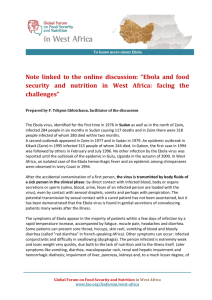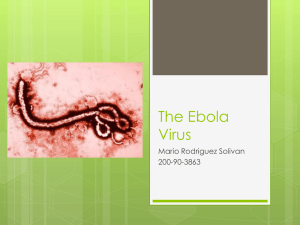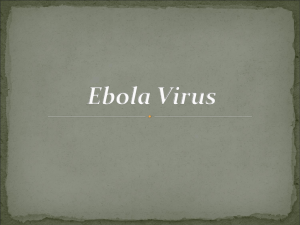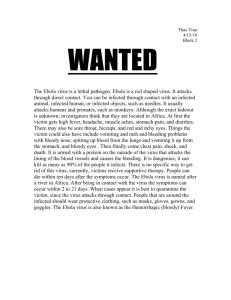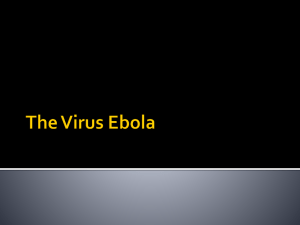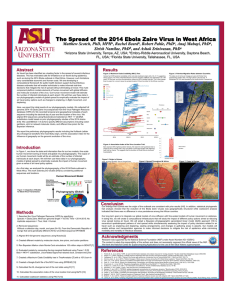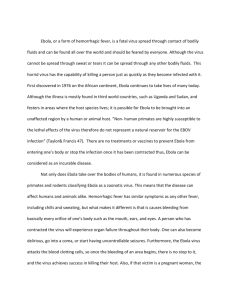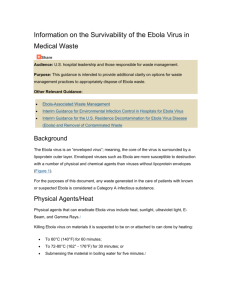Ebola Update (Word Format)
advertisement
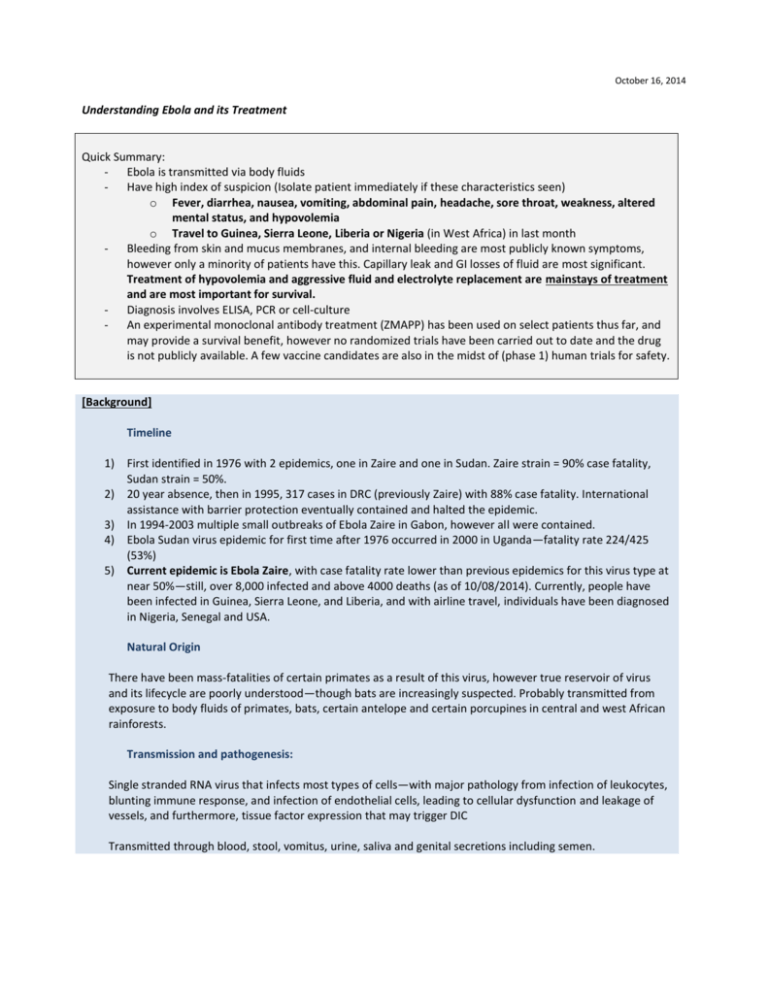
October 16, 2014 Understanding Ebola and its Treatment Quick Summary: Ebola is transmitted via body fluids Have high index of suspicion (Isolate patient immediately if these characteristics seen) o Fever, diarrhea, nausea, vomiting, abdominal pain, headache, sore throat, weakness, altered mental status, and hypovolemia o Travel to Guinea, Sierra Leone, Liberia or Nigeria (in West Africa) in last month Bleeding from skin and mucus membranes, and internal bleeding are most publicly known symptoms, however only a minority of patients have this. Capillary leak and GI losses of fluid are most significant. Treatment of hypovolemia and aggressive fluid and electrolyte replacement are mainstays of treatment and are most important for survival. Diagnosis involves ELISA, PCR or cell-culture An experimental monoclonal antibody treatment (ZMAPP) has been used on select patients thus far, and may provide a survival benefit, however no randomized trials have been carried out to date and the drug is not publicly available. A few vaccine candidates are also in the midst of (phase 1) human trials for safety. [Background] Timeline 1) First identified in 1976 with 2 epidemics, one in Zaire and one in Sudan. Zaire strain = 90% case fatality, Sudan strain = 50%. 2) 20 year absence, then in 1995, 317 cases in DRC (previously Zaire) with 88% case fatality. International assistance with barrier protection eventually contained and halted the epidemic. 3) In 1994-2003 multiple small outbreaks of Ebola Zaire in Gabon, however all were contained. 4) Ebola Sudan virus epidemic for first time after 1976 occurred in 2000 in Uganda—fatality rate 224/425 (53%) 5) Current epidemic is Ebola Zaire, with case fatality rate lower than previous epidemics for this virus type at near 50%—still, over 8,000 infected and above 4000 deaths (as of 10/08/2014). Currently, people have been infected in Guinea, Sierra Leone, and Liberia, and with airline travel, individuals have been diagnosed in Nigeria, Senegal and USA. Natural Origin There have been mass-fatalities of certain primates as a result of this virus, however true reservoir of virus and its lifecycle are poorly understood—though bats are increasingly suspected. Probably transmitted from exposure to body fluids of primates, bats, certain antelope and certain porcupines in central and west African rainforests. Transmission and pathogenesis: Single stranded RNA virus that infects most types of cells—with major pathology from infection of leukocytes, blunting immune response, and infection of endothelial cells, leading to cellular dysfunction and leakage of vessels, and furthermore, tissue factor expression that may trigger DIC Transmitted through blood, stool, vomitus, urine, saliva and genital secretions including semen. [Clinical presentation and course] - - Incubation period 2-21 days (usually 8-10 days) Early in course, patient presents with fever, diarrhea, nausea, vomiting, abdominal pain, headache, sore throat, weakness, altered mental status, and hypovolemia. Liver and kidney dysfunction often seen. Weakness is most prominent symptom Maculopapular rash with desquamation can occur near days 5-7. At this stage, a combination of liver dysfunction, endothelial damage and possible DIC, can all contribute to bleeding, at skin or mucous membranes. However, in this epidemic, less than 20% are exhibiting bleeding symptoms—and this is not necessary for death from Ebola infection. Fever may break around 12 days with eventual resolution of symptoms, however patient remains infectious from initial symptom onset until virus no longer detected in body fluids. Semen has been shown to contain virus even 7 weeks from initial presentation. [Signs and Labs] - Most prominent sign = Hypotension (from capillary leakage and GI fluid losses) Profound electrolyte losses—especially potassium Labs may also indicate leukopenia, low platelets and signs of kidney and liver dysfunction Often have laboratory evidence of DIC, however clinical relevance to treatment and survival are not clear [Diagnosis] Any of the following Antigen-Capture ELISA testing IgM ELISA testing Reverse Transcription PCR Virus Isolation by Cell Culture [Treatment] - - Hypotension and Electrolyte depletion are typically the acute causes of death o Aggressive fluid and electrolyte repletion with special focus on potassium are mainstays of treatment Replenish blood components as determined to be necessary if liver dysfunction or DIC present [Infection control measures] - Case finding, contact isolation, and contact tracing, has contained and eliminated outbreaks in past years. At the hospital: Isolate patients in private room Keep record of all interpersonal contacts Gloves, gown, eye protection, face mask and foot covers for anyone entering room Need to throw away all personal-protective-equipment avoiding contamination and contact with mucus membranes during removal Phlebotomy should be limited to the minimum necessary for diagnosis and treatment Diligent environmental cleaning and disposal of used materials is needed References: (1) General Update – Harrison’s Principles of Internal Medicine - Ebola Outbreak in West Africa, (9/10/2014) (2) Harrisons Internal Medicine – 18th edition – Chapter 197 – Ebola and Marburg Viruses (3) Infection Prevention and Control of Ebola Virus Disease in US Hospitals – CDC Video - David T. Kuhar, MD (4 )WHO Global Alert and Response Updated 8 August 2014 Prabu Selvam, MD, MHS Prabu.Selvam@wright.edu Wright Patterson AFB / WSU Emergency Medicine



